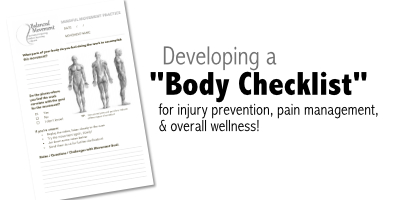Raise your hand if you love a good check list.
They serve as a mental organizer, a daily structure-builder, and a way to ensure that critical things are not overlooked. A good checklist brings our attention to little tasks to do TODAY that, if ignored, could snowball into major problems in the future.
Checklists save us from ourselves. And, of course, there’s the much-needed satisfaction of crossing things off. Accomplishment feels good!
But… have you ever considered creating a checklist for your body?
The same concepts apply. The goal a “Body Checklist” is to catch changes early and intervene. The unnoticed stiffness in the hip last weekend could be the thing that robs 45 seconds from your running pace in a couple weeks and sets up an awkward knee twist and injury next month.
[box]A Body Checklist is a routine of moves, stretches or positions that you go through if not daily, then at least 3-4 times a week.[/box]
Creating your “Body Checklist”
When developing a checklist of your own, it’s helpful to think of these 3 concepts: Simplicity, Routine and Relevancy.
SIMPLICITY:
Keep it Simple, so you will actually do it. Stick to something you can run through in 5 minutes. Limit it to 4 to 8 moves. Once you go through the checklist, if you want to do more stretching, core or strength exercise, go for it! But the Body Checklist does not have to turn into a workout every time. If it becomes too much work, it won’t get done regularly — and that, after all, is the whole point.
ROUTINE:
Same thing, same time. Each time you go through your checklist, do the same basic things. The goal is to build the knowledge of how each move ‘normally’ feels so that you immediately recognize something that is different from your norm.
It helps to do the routine at a recurring time. It could be first thing in the morning to awaken the body and start the day, the end of the day to release tension and relax in preparation for the recovery of sleep, or part of the warm up before a workout or cool down afterward.
RELEVANCY:
Your checklist should address both the activities that you normally engage in and the common areas of complaint in your body. You want to be sure that you gather information from the primary muscles, joints and movement patterns needed for your activity of choice. For example, runners need to know if anything is restricting your leg moving behind you as the opposite arm moves forward. We also all have our specific nagging parts. If the right hip and low back tend to be tired after a long ride, be sure to have a move that allows you to check in on that area. This is your checklist, let it serve your needs.
Finding your “Body Checklist” moves
To start creating your checklist movements, it can be helpful to build around familiar movement routines such as a yoga pose series or your existing warm up or cool down routines. Go through the movements slowly and mindfully, scanning your body as you go. As you move, notice what muscles contract as you gently move toward end range. Notice where the first resistance occurs, both within your body and at what point in the movement. Notice how much further can comfortably you go once you encounter the first change in resistance. See if there is anything you can relax to ease the strain of the movement. Notice these things frequently enough and you will notice familiar patterns. When something unfamiliar or different arises, you can address it.
 $1 Downloadable Movement Checklist Journal
$1 Downloadable Movement Checklist Journal
Looking for more guidance? We’ve put together a “Movement Checklist Journal” page as a downloadable PDF for just $1.
More Examples
Our Dynamic Cool Down for endurance sports is a sample of a consistent routine which you can use a foundation to apply your body inventory scan.
Below are videos that can guide you through a comprehensive body scan. To use them, find a quite place where you can comfortably stand and then transition to lying on the floor. We recommend that you watch and follow along with the videos the first time through. After that, just play, listen and follow the guidance. Take note of what components work well for you, and use all or part to develop your own routine.
As always, we appreciate you sharing feedback and requests with us.
Body Inventory Part 1
Body Inventory Part 2
Body Inventory Part 3

